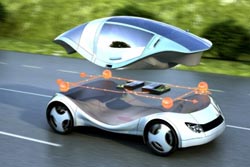Software Architecture for the Car of the Future

In vehicles built with this new technology, the driver assistance, safety, and infotainment features will mostly be installed as software instead of being managed in control units. This will reduce the current complexity of the ICT architecture and at the same time increase its power.
The partners intend to demonstrate the benefits of a centralized ICT architecture with two electric car prototypes. The recently launched project RACE (Robust and Reliant Automotive Computing Environment for Future eCars) is scheduled to run for three years and is being funded by Germany's Federal Ministry of Economics and Technology.
Today, drivers and vehicle occupants enjoy improved performance, comfort, and safety thanks to functions like the anti-lock braking system, Electronic Stability Program, active parking aid, emergency brake assistant, lane departure warning system, and proximity-controlled cruise control.
However, the associated ICT that has grown up in vehicles over many years is becoming increasingly complex. This is making the introduction of new features increasingly labor-intensive and expensive. The individual components are connected with many different data transmission systems, for example.
It is hardly possible to upgrade cars with new functions that weren't built in to the vehicles during the initial manufacturing process. Electromobility offers the opportunity to rework the ICT architecture and to quickly integrate new functions.
To this end, the partners want to bring together all the functions in a few central computers with a single bus system. The advantage here is that new systems would be installed via Plug&Play technology like on a PC – extra control units and wiring would no longer be necessary. The new architecture should also enable the vehicle to communicate with a future intelligent power grid and transport system and allow the development of completely new functions – such as an “autopilot” that could steer the vehicle autonomously in the distant future.
The ICT architecture is being implemented in two electric cars. For the “Evolution” prototype, the researchers will replace the existing vehicle technology step-by-step with new components for features such as autonomous parking or inductive charging. The “Revolution” prototype is being newly designed from the ground up.
The project partners are Siemens, TRW Automotive, AVL Software and Functions, fortiss, Institut ILS at the University of Stuttgart, the departments Software & Systems Engineering and Real-Time Computer Systems at the TU München, Fraunhofer Research Institution for Applied and Integrated Security (AISEC), and the RWTH Aachen (ACS/ISEA).
Media Contact
More Information:
http://www.siemens.com/innovationnewsAll latest news from the category: Automotive Engineering
Automotive Engineering highlights issues related to automobile manufacturing – including vehicle parts and accessories – and the environmental impact and safety of automotive products, production facilities and manufacturing processes.
innovations-report offers stimulating reports and articles on a variety of topics ranging from automobile fuel cells, hybrid technologies, energy saving vehicles and carbon particle filters to engine and brake technologies, driving safety and assistance systems.
Newest articles

High-energy-density aqueous battery based on halogen multi-electron transfer
Traditional non-aqueous lithium-ion batteries have a high energy density, but their safety is compromised due to the flammable organic electrolytes they utilize. Aqueous batteries use water as the solvent for…

First-ever combined heart pump and pig kidney transplant
…gives new hope to patient with terminal illness. Surgeons at NYU Langone Health performed the first-ever combined mechanical heart pump and gene-edited pig kidney transplant surgery in a 54-year-old woman…

Biophysics: Testing how well biomarkers work
LMU researchers have developed a method to determine how reliably target proteins can be labeled using super-resolution fluorescence microscopy. Modern microscopy techniques make it possible to examine the inner workings…





















